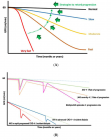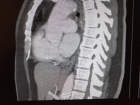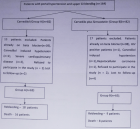Table of Contents
Mechanism of Action and Validation of the Traditional Medicinal use of Grewia Tenax Fruits in Sudan to Encounter Iron Deficiency Anemia
Published on: 27th December, 2023
Introduction: In Sudan, Grewia tenax fruits, are known commonly as Goddaim. The fruit’s pericarp is used traditionally for a long time as a juice or a porridge to treat iron deficiency anemia (IDA). Traditional Goddaim users have a very strong belief in its effectiveness. However, the pattern of hemoglobin improvement follows an initial fast increase followed by a decline upon continuing its use. Some previous studies have attributed its effect to high iron content, while the iron quantity was too small. This work attempts to find an explanation for its mechanism of action by screening the fruit extract and its respective fractions for secondary metabolites, minerals, vitamins, and fibre. Methods: Entailed three methodologies: Chemical analysis to identify quantified minerals, ascorbic acid and non-digestible fibers, Phytochemical Analysis to separate and identify secondary metabolites using high-performance liquid chromatography coupled to tandem mass spectrometry (HPLC-MS-MS technique), and estimation of radical scavenging activities of crude fruit extract and its respective chloroform and ethyl acetate fractions by inhibition of the 2,2-diphenylpicrylhydrazyl (DPPH).Results: Ascorbic acid and indigestible fibres were revealed in the aqueous extract. Secondary metabolites were flavonoids (e.g., quercetin, kaempferol), organic acids (e.g., ferulic acid, chlorogenic acid), β-carboline alkaloids (e.g., 3-hydroxy-tetrahydroharman) identified in the chloroform, and ethyl acetate fractions. The in vitro antioxidant activity of G. tenax fruit extract was confirmed spectrophotometrically. Conclusion: It can be concluded that the initial enhancement of iron absorption through ascorbic acid and fibres, followed by iron uptake inhibition, could be explained by iron chelation by the chelators in the fruits. This paradoxical effect may qualify G. tenax fruits as a safety gauge for improving haemoglobin levels without compromising iron excess once iron stores are filled by keeping the oxidative stress in check. This may present G. tenax fruits as a good and safe remedy that optimizes the treatment of IDA.
A Rare Case of an Acquired Isolated Factor VII Deficiency was Discovered in a 23-Year-Old Female Patient
Published on: 20th September, 2023
Introduction: Factor VII (FVII) deficiency, a rare bleeding disorder, can manifest as an autosomal recessive congenital or an acquired coagulopathy. Acquired FVII deficiency, although infrequently reported, presents unique challenges in understanding its mechanisms and identifying underlying causes. Case presentation: We present a case of acquired FVII deficiency discovered in a 23-year-old female patient with no apparent underlying disease. The patient exhibited spontaneous ecchymosis and gingival hemorrhage, along with low FVII activity and isolated prolongation of prothrombin time. Extensive laboratory investigations excluded liver dysfunction, familial deficiency, vitamin K deficiency, and inhibitory antibodies. Prompt treatment with Fresh Frozen Plasma (FFP) and bypassing agents resulted in a favorable response and resolution of hematomas. Conclusion: Acquired FVII deficiency was identified with bleeding symptoms in association with prolonged prothrombin time and a low level of FVII activity. In literature, this deficiency has been associated with various conditions such as sepsis, aplastic anemia, stem cell transplantation, and neoplasms, although approximately 14% of cases remain idiopathic. Clinical outcomes remain generally poor, with limited complete remissions reported.
Role of RBC Parameters to Differentiate between Iron Deficiency Anemia and Anemia of Chronic Diseases
Published on: 27th July, 2023
Introduction: In the present study we evaluated and compared RBC parameters, iron status, and ferritin for discriminating between patients with iron deficiency anemia and anemia of chronic disease. Anemia that accompanies infection, inflammation, and cancer, is commonly termed anemia of chronic disease (ACD). Methods: We compared the ability of serum ferritin concentration, using the microplate immunoenzymometric assay method with other, more traditional indicators of iron status like total iron binding capacity [TIBC], mean corpuscular volume [MCV], percent transferrin saturation [%TS], RBC distribution width [RDW], and serum iron concentration [SIC]. The ferritin concentration was determined in 80 serum samples selected from men and women above the age of 18 years. The patients were assigned to IDA and ACD groups based on serum ferritin concentration.Observation: By studying the ROC Curve for various red cell parameters for the diagnosis of IDA and ACD, we found that diagnostic accuracy of various indicators was as follows TIBC>TS%>MCV>MCH>SI>MCHC for anemia of chronic diseases, and TIBC>MCH>MCV>MCHC>TS%>SI for iron deficiency anemia. When both the value of AUCs (Area under Curve) of ROC were compared it is apparent that TIBC, TS%, MCV, and MCH are important discriminating factors between IDA and ACD. Conclusion: Conventional laboratory parameters play an important role in distinguishing overt causes of IDA and ACD. MCV, MCH, and TIBC were found to be (p -value < .05) significantly discriminated against IDA and ACD. Serum ferritin is an important diagnostic tool with reasonable accuracy for the detection and differentiation of iron deficiency anemia and anemia of chronic disease.
Evaluation of the Bone Marrow Aspirate Examination Practice at the University Hospital Andrainjato Fianarantsoa, Madagascar
Published on: 5th July, 2023
Introduction: The bone marrow aspirate examination is defined as a quantitative and qualitative study of bone marrow cells obtained by puncture and aspiration. Aim: Our objective was to evaluate the practice of this exam at Andrainjato Fianarantsoa University Hospital in order to improve its diagnostic relevance.Method: This is a prospective and descriptive cross-sectional study of all bone marrow aspirates performed at the Andrainjato Fianarantsoa University Hospital Madagascar, during 18 months, from January 2021 to June 2022.Results: Forty-two bone marrow aspirate examinations were performed during the study period, among the 338 requests for hematological analysis received, representing a percentage of 1.26%. The average age of the patients was 32.17 years, with a sex ratio of 2.5. The prescription was of hospital origin in 83.3% of patients, motivated by the disturbance of the blood count in 78.6% of cases. Thirty-three requests were evaluated as relevant prescriptions. Coupled with the realization of the bone marrow examination, the haemograms were pathological in 78.6% of cases. The result of the bone marrow aspirate showed normal marrow cytology (16.7%), reactive marrow (23.8%), pathological marrow (50.0%), and hemodiluted marrow (9.5%). Dysmyelopoiesis (33.3%), multiple myeloma (23.8%), and acute leukemia (19.0%) were the main pathologies found. The difficulties encountered were related to the poor quality of the equipment and the non-availability of other complementary explorations.Conclusion: The bone marrow aspirate examination is technically feasible at Andrainjato Fianarantsoa University Hospital despite the existence of difficulties. The commitment to the process of continuous improvement of quality would impose the improvement of the technical platform.
Mechanism of Small Molecule Inhibitors of Phagocytosis
Published on: 3rd July, 2023
Immune cytopenias occur when the body produces antibodies that target specific hematopoietic cells, inducing extravascular antibody-mediated phagocytosis by monocyte-macrophages in the spleen and/or liver through activation of Fcγ Receptors (FcγRs). Immune cytopenias include Immune Thrombocytopenia (ITP), Autoimmune Hemolytic Anemia (AIHA), Hemolytic Transfusion Reactions (HTR), Hemolytic Disease of the Fetus and Newborn (HDFN), and Autoimmune Neutropenia (AIN). Thus, novel therapeutics that inhibit phagocytosis would be useful, especially for short-term use while other therapies are being evaluated. In our earlier studies, we successfully identified two small-molecule drugs able to inhibit in vitro phagocytosis with a low IC50 concentration and negligible toxicity. These drugs, known as KB-151 and KB-208, have the potential to be utilized as lead compounds for further studies, once their mechanism of action is more clearly understood. In this regard, we have developed preliminary results that suggest that these small molecules may bind to the Fc receptors on monocyte macrophages and block the subsequent attachment of antibody-opsonized red blood cells to prevent phagocytosis.
Systemic sclerosis sine scleroderma presenting as renal crisis, a case report and review of the literature
Published on: 17th April, 2023
Systemic sclerosis sine scleroderma is a rare subset of systemic sclerosis with isolated organ involvement. Scleroderma renal crisis is a severe manifestation of systemic sclerosis characterized by malignant hypertension, oligo/anuric renal failure, and thrombotic microangiopathy. We present a case of a 55-year-old male with uncontrolled hypertension who presented with hematospermia and was found to have acute renal failure, microangiopathic hemolytic anemia, concerning thrombotic microangiopathy. Empiric management for thrombotic thrombocytopenic purpura (TTP) with plasma exchange and corticosteroids yielded a paradoxical response, ultimately leading to the diagnosis of systemic sclerosis sine scleroderma presenting as scleroderma renal crisis (SRC) after serological confirmation. Given the morbidity and mortality associated with scleroderma renal crisis, it should be increasingly considered as a differential for thrombotic microangiopathy even without outward manifestations of systemic sclerosis. Additionally, the empiric management of TTP can include the use of corticosteroids which can exacerbate SRC, an early clinical clue in the diagnosis of this disease.
Prospective evaluation of a computerized algorithm for Vitamin K antagonist drug dose calculation
Published on: 16th February, 2023
Introduction: In an earlier study, we described and validated a VKA dose-finding algorithm (B2A), based on a novel bidirectional factor (BF). We designed a prospective study to evaluate the B2A in a daily care setting. Methods: In this open-label prospective study, we compared the outcomes of the B2A over the year 2020 with the outcomes of the previous year (2019), using regular algorithms. The outcomes were the duration of Time in the Therapeutic Range (TTR), the percentage of automated dose proposals (PAuP) and the percentage of accepted dose proposals (PAcP). The data were obtained from three anticoagulation centers in the Netherlands, in four locations. The outcomes of this study were based on a non-inferiority level.Results: The TTR over the year 2020 was at least non-inferior compared with the standard of care treatment. The percentage of automated proposals increased in all centers to approximately 96% of all dosages. Conclusion: The B2A performs non-inferior compared with the existing algorithms and in some aspects even better.

HSPI: We're glad you're here. Please click "create a new Query" if you are a new visitor to our website and need further information from us.
If you are already a member of our network and need to keep track of any developments regarding a question you have already submitted, click "take me to my Query."




















































































































































